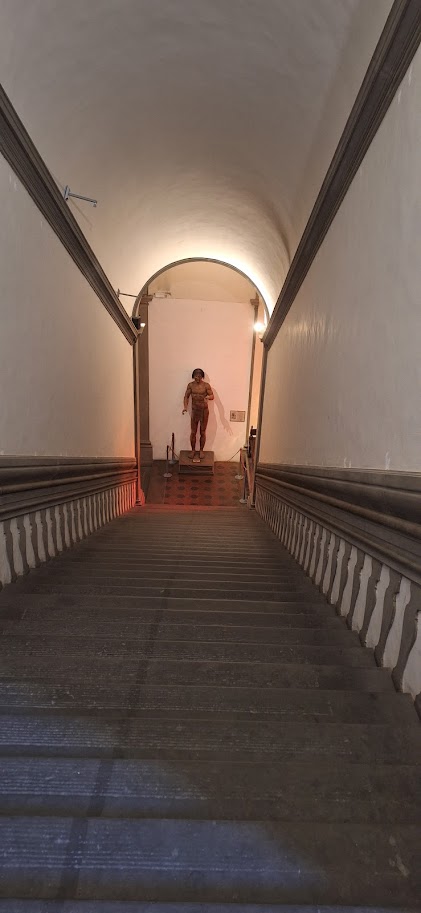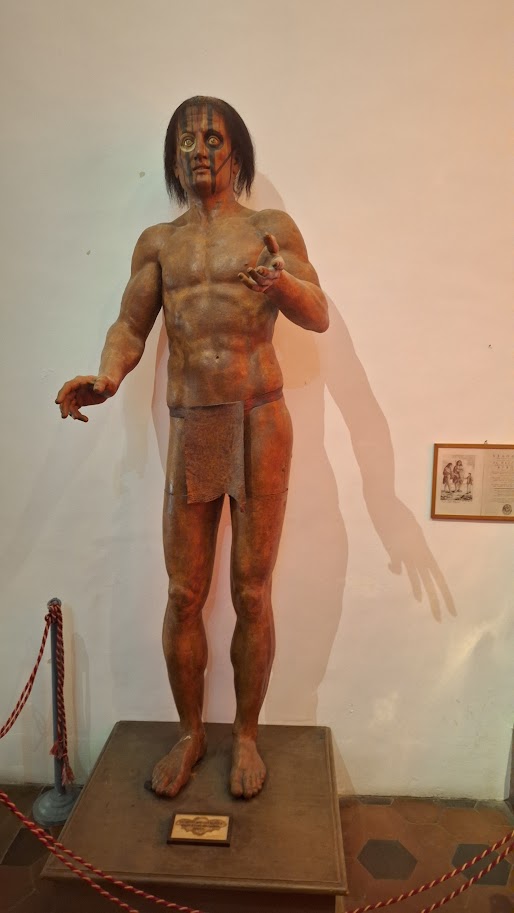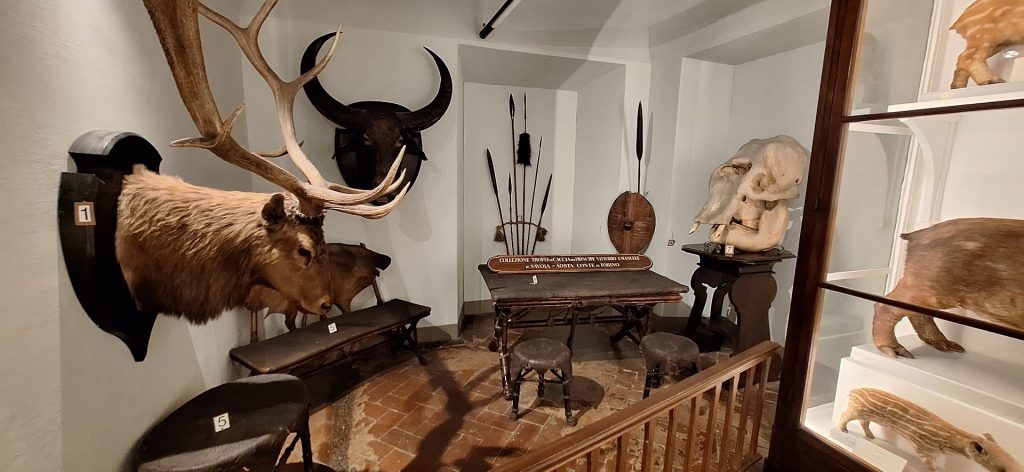Written by Nathaniel Oldenburg, Roger Williams University | ISI Florence Fall 2024
Florence’s Museum of Natural History refers to four museums run by the University of Florence. They are on the smaller side compared to the larger museums that Americans might be used to like the Smithsonian or the American Museum of Natural History in New York, but they are all worth a visit. It includes the Botanical Garden, the Museum of Geology and Paleontology, the Museum of Anthropology and Ethnology, and La Specola. The Botany Museum also falls under the umbrella of these University of Florence museums but is available for research purposes only.
The Botanical Garden “Giardino dei Semplici“

One of the indoor sections of the Botanical Garden “Giardino dei Semplici.”
I visited the Botanical Garden “Giardino dei Semplici” on the last day of August when it was still quite hot. With the exception of a few rooms, the Botanical Garden is outside so if visiting during the hotter months it is more than recommended you bring a water bottle. The garden is on Via Pier Antonio Micheli 3, not too far from the Museum of Geology and Paleontology, the Florence Museum of Archaeology, and the Piazza della Santissima Annunziata, which also contains the Hospital of the Innocents, another museum.
If you want to visit as many museums as possible in a single day, you can check off the museums near the Piazza della Santissima Annunziata and the Natural History museums.
The plants and trees of the Botanical Garden are beautiful, as is the fountain in the center and a few of the neoclassical statues around, the common style of Florence sculpture. A stroll through the garden can be soothing, even with unbearable heat and flies in the vicinity. The few indoor rooms are worth visiting, not only for containing more exotic and large trees from places like Papua New Guinea but also because their white color and simple architecture give off a dreamlike, liminal feeling.
The Museum of Geology and Paleontology

While I had a great time at the Museum of Geology and Paleontology on via Giorgio La Pira 4, dinosaur fans who may have been spoiled by natural history museums in the US might want to notch their expectations down just a bit. It’s a smaller building with fewer fossils than what might be expected. Like nearly all Florentine museums, the staff would appreciate it if you didn’t wander and follow arrows on the floor in order to go about the museum on a self-guided tour. The Museum of Geology and Paleontology’s plan corresponds with different phases of life’s development on our planet. Still, there are incredible intact skeletons, mostly mammals like mastodons and cave bears, that are worth seeing. The museum is currently holding an exhibit on the remains of a prehistoric whale and all that was found within it such as the jaws of a prehistoric shark. It’s held in a dark, cool, air-conditioned room which really ties the experience together.
The Museum of Anthropology and Ethnology
The Anthropology and Ethnology Museum on via del Proconsolo 12 was a real highlight for me. The Florence Natural History Museums have an old-school feeling to them. I define “old school” as feeling more academic and scientific, utilizing harsh lighting, housing specimens in glass cases with minimal plaques or informative cards, and older buildings with smaller rooms, as opposed to more modern museum exhibits which try to appeal to younger children and families by being “experiences”, using mood lighting, interactive games, and larger print plaques. These old-school museums on the other hand feel like they were made by turn-of-the-century scientists for other turn-of-the-century scientists, and because of this, they can feel liminal, eerie, and creepy, especially when you’re walking alone through the exhibitions, or when you’re seeing things like taxidermied animals or preserved human body parts. The Anthropology and Ethnology Museum definitely has that old-school, creepy vibe, though its subject matter is not as morbid as certain halls in La Specola.

A fearsome Garuda statue casts impressive shadows in the Anthropology and Ethnology Museum’s India room.
The Museum of Anthropology and Ethnology hosts wax models in the costumes of various cultures throughout Asia, Africa, the Americas, and the Pacific as well as their artifacts in glass cases, such as Incan mummies, shrunken heads from the Amazon, Japanese kimonos, and more. These glass cases are at eye height, and given the smaller size of the rooms, as well as the fact that these museums are not as popular as Florence’s bigger draws such as the Uffizi, Duomo, or Palazzo Vecchio means you’ll often be touring alone, can make it easy for one to get startled by mistaking a wax model in the room for another person.
This happened to me, when, after passing a wall of staring Japanese noh theater masks and an array of painful-looking harpoons, I shocked myself by running into a wax model of a Patagonian Giant next to a long, narrow flight of stairs.
The Anthropology and Ethnology Museum has a feeling of adventure, exploration and discovery. The art, fashion, and artifacts on display are vibrantly beautiful, and the museum serves to celebrate the rich, diverse tapestry of human life.


La Specola
Finally, there is La Specola, a museum devoted to the natural sciences and the oldest public museum in Europe since 1775. It contains a hall of geology, collections of taxidermied animals, and a special exhibit of wax anatomical figures. While there is room for these wax anatomical works available with a normal admission ticket, if you want to see their truly vaunted collection of anatomical statues of the famed Clemente Susini, you’ll have to take a guided tour. Private tours cost an extra 3 euros and are only available at 11 AM, 12 PM, and 3 PM from Tuesday to Sunday. La Specola also has the Tribune of Galileo, a special room dedicated to Galileo Galilei containing instruments that belonged to him. According to their website, you can only visit with a guided tour on Sundays at 11 AM up until the end of October, upon which they will change to only Sundays at 10 AM.
The Hall of Bones is another attraction of La Specola, showcasing skeletons of various animals including prehistoric ones. Unfortunately, you cannot get a ticket online or at the ticket office. You need to contact the Educational Services of the University Museum System, available via phone call between 9 AM and 1 PM from Mondays to Fridays or by email. I have yet to visit the Tribune of Galileo or the Hall of Bones, unfortunately. When I emailed Educational Services to arrange a visit to the Hall of Bones, they told me the price would be 50 Euros in addition to an ordinary admission ticket of 10 Euros.
Though a lot of the museum being behind paywalls or special reservations is annoying, La Specola is still a surreal yet rewarding experience. Just like the Museum of Ethnology and Anthropology, it has that creepy, old-school museum vibe, but this one was a bit spookier. Again, the specimens are all at eye height, so when you walk through the halls of taxidermied animals or flayed human bodies, you feel you are being watched, especially when the halls are of smaller size, and, again, you will often find yourself walking alone. The animal specimens come from an older, somewhat imperfect stage of taxidermy, and thus, are just a little bit off as seen by this staring, almost comical puffer-fish below.
Walking among harshly lit, quiet, white-colored chambers surrounded by dead, preserved animals ranging from apes to insects and more, or anatomical wax models of human bodies in various states of dissection and disassembly (built off of molds of very real human body parts) can only be described as as a little creepy. When I went to visit the special Clemente Susini wax models with a tour guide (Herman Melville, author of Moby Dick visited and was reportedly horrified) to see the fascinating yet macabre anatomical venuses, wax models of beautiful, vivisected women in Renaissance painting poses, I couldn’t help but notice that in front of the hall’s entrance and exit were locked black, spiked, iron gates, a little too similar to those of a cemetery.
Still, as bizarre and somewhat frightening La Specola could be, it was more than informative, and one appreciates the sheer artistry that abounds in the place. The flayed, dismembered and disemboweled anatomical models were not designed to frighten but to inspire, educating the public on medicine and biology. They are posed like Renaissance sculptures, as if alive, to celebrate the Neo-Classical and Enlightenment values that led to the study of anatomy and the creation of museums such as this one. For those less interested in stuffed animals and anatomical sculptures, an admission ticket to La Specola also has a gorgeous hall of minerals and precious gems, all of which are a sight to behold.
Florence’s Natural History Museums are just like the city itself—utterly unique. Oddball yet inspiring, intense yet edifying, when visiting one you never really know what you’re going to get. I recommend visiting the Natural History Museums not only to try something off the beaten path but also to get away from the clogged lines and waiting lists of the Uffizi and Duomo. In fact, for me, these visits were either somewhat or entirely solitary experiences, especially if I visited earlier in the morning, making for introspective and dramatic experiences, ideally what all museums would provide. They make for great visits and great stories for those back home. If you do decide to visit, however, try to find something that stands out to you and you alone, a room that scared you, a specimen you found beautiful, a new fact you learned. You’ll appreciate these museums, and Florence, all the more for it.



